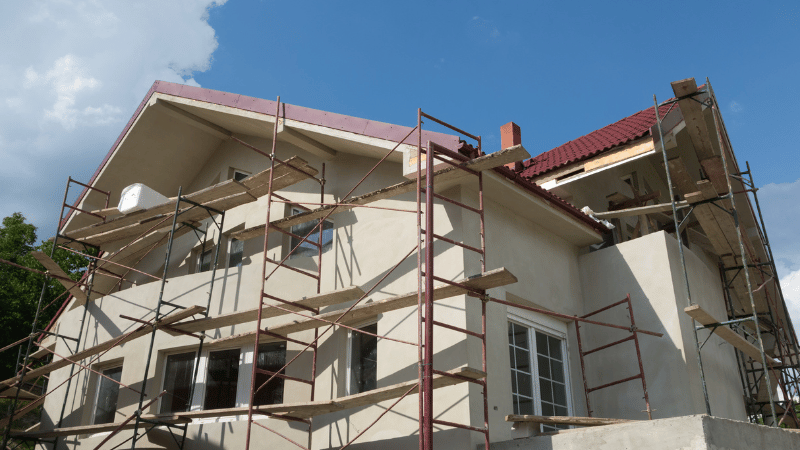Categories
A Full Guide To Financing Your Next Property Renovation: Refurbishment Bridging Loans

Whether you're an established developer with a large property portfolio or a first-time investor just getting into property investment, refurbishment finance can be an extremely useful tool to help you take advantage of those golden opportunities that come your way.
So, what is refurbishment finance?
Here are 3 key points:

Refurbishment finance (sometimes known as a refurbishment mortgage, refurbishment loan, or renovation mortgage) is a short-term loan used to fund a property purchase and any light or heavy development work that needs to be done.

You can raise a significant amount of refurbishment finance quickly to 'bridge' the gap in funding your project, and you can repay the loan when you either sell the property or refinance it through a mortgage.

The application process for refurbishment finance is much simpler and faster than a traditional mortgage loan. In fact, we've helped clients raise funds in a matter of days.

Finance Property Renovation with a Bridge Loan
Get started with our calculator
Skip to:
Who Can Get Refurbishment Bridging Finance?
What Can Refurbishment Bridging Finance Be Used For?
Light and Heavy Refurbishment Loans - What's The Difference?
How Much Can I Borrow to Refurbish a Property?
Refurbishment Finance Calculator
How Quickly Can I Get Refurbishment Finance?
How Do I Apply For Refurbishment Finance?
Why Use a Property Finance Broker?
Who Can Get Refurbishment Bridging Finance?
You can be eligible for refurbishment bridging finance as an individual, a sole trader, or through a limited company.
Refurbishment finance is often used by property developers andfirst-time property investors for house flipping, which involves purchasing and renovating a property to sell it for a quick profit.
Landlords also commonly use them to finance buying and refurbishing buy-to-let properties.
You don't have to be an experienced property developer or landlord to get finance for your property refurbishment. Most lenders will approve your application if you have a solid exit strategy to repay your loan at the end of the term.
Every lender's application criteria vary, but if you can meet the following requirements, you should be able to access the refurbishment funds you need within days rather than weeks:
Lending criteria for refurbishment finance
- The address of the property - its build, location and suitability for raising finance against.
- Net wealth - to determine other assets you own in case you can't repay your loan.
- Having a solid, realistic plan on how to get your property from A to B using your refurbishment finance
- An exit strategy - will it be easy to get a long-term buy-to-let mortgage or to sell the property when your work is complete?
And keep in mind that:
- Some lenders only offer 'light' refurbishment loans for first-time landlords and investors.
- A poor credit history is not usually an issue for refurbishment finance, as your ability to repay isn't based on your income.
Related: Read our guide on how to use a renovation bridging loan to buy and renovate a house for a profit

Fergus Allen
Head of Bridging
Let us do all the hard work of finding the right bridging lender for your circumstances.
We secure bridging finance for applications of all types, and we negotiate competitive lending to meet your needs and timescale.
What Can Refurbishment Bridging Finance Be Used For?
Refurbishment finance is designed to support small development projects. It's different from property development finance, which is another ball game that generally applies to ground-up developments.
So, if you're a landlord or looking to flip a property, you can apply for refurbishment finance for the following:
- Refurbishment costs on commercial or residential property
- Minor cosmetic alterations such as redecoration, a new bathroom or kitchen
- EPC improvements
- Plumbing and drainage work
- Rewiring and electrical work
- Major structural changes, extensions, and change-of-use conversions, i.e. from commercial to residential (typically requiring planning permission)
Related: How to buy an unmortgageable house & How to Get Finance to Buy an Uninhabitable Property

Light Refurbishment and Heavy Refurbishment Loans - What's the Difference?
Depending on the work you plan to do, you will be offered a light or heavy refurbishment loan. They come with different rates and application criteria.
Light refurbishment loan
This type of work doesn't need planning permission or building regulation checks. The intended use of the building remains unchanged, and you don't need to have experience completing previous home improvements. The work can be done by either you or a contractor of your choosing.
You can borrow up to 85% of the property value, and some lenders will also allow you to borrow 100% of the amount needed to complete the refurbishment costs.
See similar: Home Improvements That Add the Most Value
Heavy refurbishment loan
Heavy refurbishment loans are available for properties when planning and building regulations are required. This includes structural works like an extension or if the work will lead to a change of use, such as when a 5-bedroom house is converted into a 9-bedroom multi-occupancy home.
- Lenders will often want to see that you have some property refurbishment experience.
- They will also want to check the list of work, time schedules and costs, and the contractors you have in place to make the project successful.
- Your planned exit will also be assessed (sale of property or refinance through a mortgage).
Related: Home Improvement Loans - The 7 Best Options
How Much Can I Borrow to Refurbish a Property?
- Loan size: Most refurbishment finance lenders will consider loans from £25,000 up to £25m.
- Loan To Value: The maximum loan to value is typically 85%, meaning on a property worth £100,000, you can borrow £85,000. Getting 100% LTV refurbishment is possible if you can provide extra security.
Refurbishment Finance Calculator
Use our refurbishment finance calculator below to get an indicative quote of what a refurbishment bridging loan might cost you.
Refurbishment Finance Rates
Flipping Property?
Buying, Renovating & Selling (or Letting)
Finance Rates from
0.55% pm
1 - 18 months
Rates up to 80% LTV net
As at 17th January 2025
Ground Up Development
New Builds
Finance Rates from
0.83% pm
Up to 24 months
Rates up to 70% of GDV
As at 17th January 2025
Existing Development?
Refinance & Exit Finance
Finance Rates from
0.55% pm
1 to 18 months
Rates up to 80% LTV net
As at 17th January 2025
Contact Us
Thank You for your interest - please complete the form below and a member of our team will be in contact.
How Quickly Can I Get Refurbishment Finance?
You can expect a decision in principle within 24 hours of applying.
And you can expect to have the funds in your account within 7-14 days. In some cases, the cash can be released within a few days, but it depends on the specifics of your case.

How Do I Apply for Property Refurbishment Finance?
Our team of expert brokers can match you with the lender offering the most competitive loan for your property.
Here are 5 steps to the process:
- Step 1: Contact our property finance experts to discuss your requirements. We'll assess your application and connect you with the right lender.
- Step 2: We'll strive to get you an offer in principle within 24 hours.
- Step 3: Your chosen surveyor can value the property to meet everyone's expectations.
- Step 4: We'll send your solicitor a checklist of requirements. If the valuation report is acceptable for the agreed loan terms, we'll confirm this with your solicitor and then issue the mortgage deed for your witnessed signature.
- Step 5: As soon as the lender's solicitor receives all crucial information and supporting documentation, you're ready to go! Within 24 hours of receiving the report on title, we arrange the transfer of funds to your solicitor, who will then release them to your bank account.
Related: How to find the best bridging loan deals
Why Use a Property Finance Broker?
Our property finance broker team has expert knowledge of the short-term lending market, meaning we can meet the needs of a wide variety of property investors and landlords.
From start to finish, your dedicated broker will guide you through the process, be readily available to answer any questions and relieve your stress and hassle.
Our strength is our ability to access various funding solutions from high street and private banks, specialist lenders, family offices and wealth managers. We also have connections with private investor fund groups.
Call us on 0203 900 4322 to discuss your requirements, or book a free consultation below.












